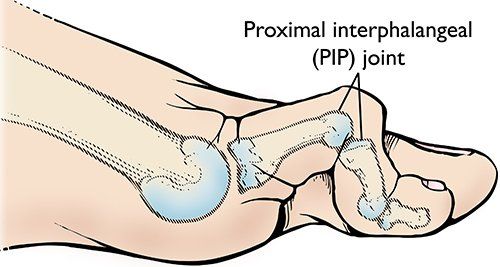Foot & Ankle
Toe Deformities
Toe deformities are common conditions that affect the alignment of the bones, joints, and tissues in the foot. These deformities can disrupt normal foot function and may also affect the alignment of weight-bearing joints, such as the hips or knees, leading to further complications. The most common toe deformities include claw toe, hammer toe, and mallet toe.
Types of Toe Deformities
Claw Toe
Claw toe is characterised by an abnormal bend in the toe that resembles a bird’s claw. This deformity occurs when there is an imbalance between the intrinsic and extrinsic muscle systems of the toe, often due to nerve damage or external forces. The affected toe bends upward from the joint at the ball of the foot and downward at the middle and tip joints, causing the toe to curl under the foot. This can result in painful corns or calluses on the top or bottom of the toe. Claw toe is more common in women, often due to wearing tight, high-heeled shoes, and can also develop due to conditions such as rheumatoid arthritis, cerebral palsy, or brain injury.

Hammer Toe
Hammer toe occurs when one of the toes (usually the second, third, or fourth toe) is bent at the middle joint, forming a shape similar to a hammer. This condition leads to pain, particularly on the top of the toe joint, and often results in corns. Hammer toe typically results from a muscle imbalance that puts pressure on the tendons and joints of the toe, causing the joint to tighten over time. If left untreated, it can lead to permanent deformity.

Mallet Toe
Mallet toe is similar to hammer toe but affects the joint at the tip of the toe instead of the middle. This condition also causes the toe to bend downward, leading to discomfort and difficulty walking. Like hammer toe, mallet toe can occur due to muscle imbalance or other underlying conditions and can cause significant pain if not treated.

Symptoms of Toe Deformities
Common symptoms of toe deformities include:
- Pain while wearing shoes.
- Swelling and redness around the affected joint.
- Inability to straighten the toe.
- Corns or calluses on the affected joint or tip of the toe.
- Difficulty walking due to restricted motion or pain.
Causes of Toe Deformities
Toe deformities can be congenital (present at birth) or acquired later in life. Common causes include:
- Improper footwear, particularly tight shoes and high heels, which place pressure on the toes and cause misalignment.
- Neurological conditions, such as stroke, diabetes, or rheumatoid arthritis, which can lead to muscle weakness or tightening of tendons and ligaments.
- Foot injuries or trauma that cause fractures, leading to misalignment of the toes.
- Genetics: Some individuals are more predisposed to developing toe deformities due to family history.
Diagnosis of Toe Deformities
The diagnosis of toe deformities typically involves a medical consultation and physical examination. During this process, the healthcare provider will inspect the foot for visible deformities and assess any pain, swelling, or restricted motion. Additional tests, such as X-rays or MRI scans, may be performed to rule out other conditions or confirm the diagnosis.
Treatment Options for Toe Deformities
Non-Operative Treatment
In the early stages, toe deformities may be flexible and can often be managed without surgery. Treatment options include:
- Stretching exercises: Regular stretching of the toe joints can help improve flexibility.
- Footwear modifications: Wearing
soft, comfortable shoes with a wider toe box and avoiding tight, high-heeled shoes can alleviate pressure on the toes.
- Splinting or taping: In some cases, splinting or taping the toe can help realign the joint and relieve discomfort.
Surgical Treatment
If non-operative treatments fail or the deformity becomes rigid and painful, surgery may be recommended to restore proper alignment and function of the toe. Surgical options include:
- Soft tissue realignment: If some flexibility remains, the surgeon may make an incision over the deformed joint, realign the tendons and ligaments, and insert
pins to maintain alignment during the healing process.
- Osteotomy: In cases of fixed deformity, the surgeon may perform an osteotomy (removal of bone pieces) to realign the joint and improve mobility.
Pins may also be inserted to secure the toe in its new position.
Why Choose Dr. Ryan du Sart for Toe Deformity Treatment?
Dr. Ryan du Sart is a highly trained orthopaedic surgeon specialising in foot and ankle conditions, including toe deformities. With years of experience in diagnosing and treating a range of foot issues, Dr. du Sart offers personalised treatment plans tailored to the unique needs of each patient, from non-surgical interventions to advanced surgical techniques.
Book a Consultation
If you are experiencing pain or difficulty walking due to a toe deformity, early intervention can help prevent further complications. Book a consultation with Dr. Ryan du Sart today to explore your treatment options and take the first step toward relief.
Phone: (08) 9779 9767
Email: admin@ryandusart.com.au
Locations:
6 Higgins Street, South Bunbury, WA 6230
20 Prince Street, Busselton, WA 6280
References:
- Pfeiffer, A. J., & Liggins, A. B. (2019). "Treatment Strategies for Hammer Toe Deformities: A Review."
Journal of Foot and Ankle Surgery, 58(5), 877-883.
- Johnson, W. R., & Reichenberger, E. J. (2020). "Minimally Invasive Approaches for Toe Deformities: A Review."
Journal of Orthopaedic Surgery and Research, 15(1), 70-78.
- Rosen, J. S., & Williams, T. M. (2021). "Management of Bunion and Toe Deformities: A Review of Surgical and Non-Surgical Options." Foot and Ankle Clinics, 26(3), 457-470.

